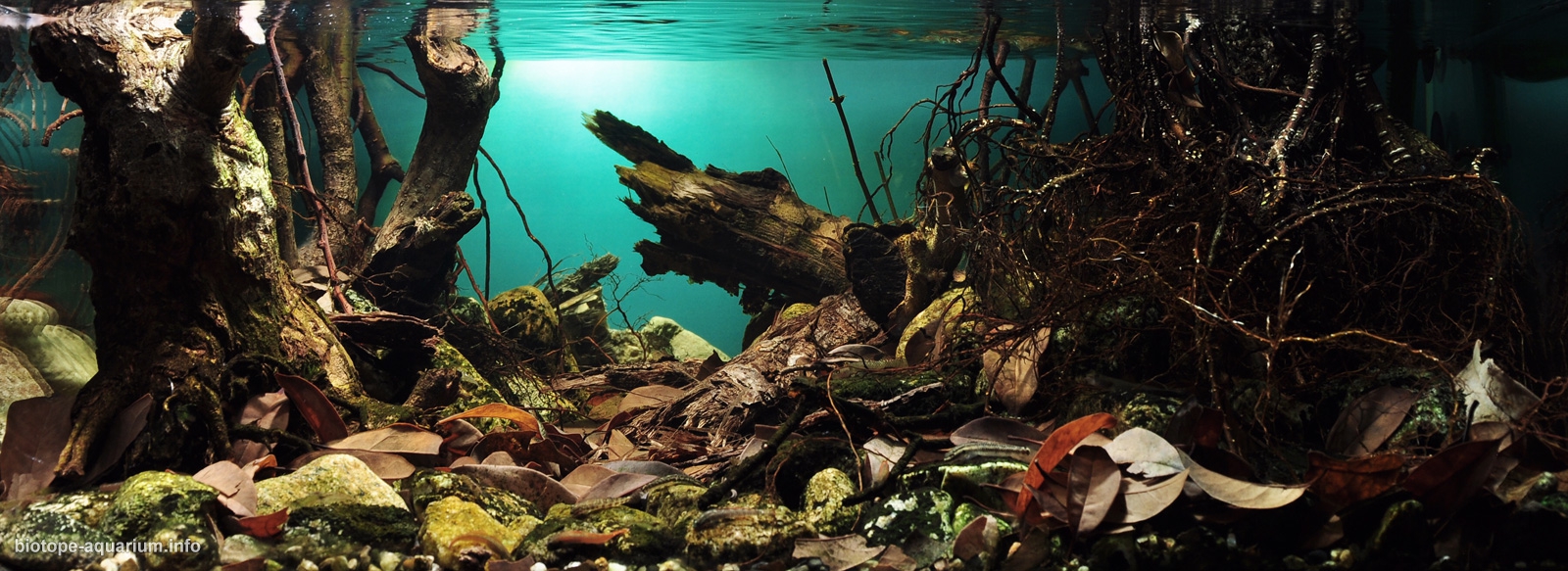Slow flowing stream under the trees, Halmahera, Indonesia
16th place in Biotope Aquarium Design Contest 2018
![]() China. Nan Li
China. Nan Li

Volume: 67 L
Dimensions: 60x45x25 cm
List of fishes: Stiphodon annieae
List of plants: N/A
Description of decorations: At the end of 2017, after seeing my good friend Hammer’s mysterious documentary of his way to Halmahera Island (Maluku) in Indonesia to find Stiphodon Annieae, I deeply loved and developed a strong interest in the distant, mysterious and beautiful native land. The idea of building up a biotope tank for Stiphodon Annieae came to my mind. In order to get as close as possible to the natural environment of the native stream Stiphodon Annieae lives, I spent a lot of time on the design of tank size, light and filtering system. A good choice of tank size is the primary condition of natural habitat restoration. Since the maximum allowed length is only 60cm in my office, I decide to choose a size of 60x45x25cm, which allows me to layout an ideal landscape in such a small space. The 45cm width can give me an opportunity to simulate the gradient of the real riverbed and build a good view depth. The 25cm height could reproduce the shallowness of the original stream. For lighting system design, I chose the Netlea AT1 50w LED. The LED light, which has a 7500k color temperature, is quite similar to the natural light of the midday sunshine. The long-term illumination makes the sands and stones in the tank full of brown algae and green algae, which provide abundant natural foods for Stiphodon annieae and other gobies. For filtering design, I chose EHEIM 600 classical filter (1000 liters/hour) as the power barrel. The actual water body in the tank is only about 50 liters, and the water filtration cycle per hour is about 20 times, which provides the fish with a clear and stable water quality comparable to the original. In order to get close to the natural environment, all landscape materials are almost collected from the wild field. The material is dominated by stones, branches, leaves and small gravel. I placed a small living tree on the right side and let its roots immerse in the water, which provides hidden areas for small fishes. In the meanwhile, the fish excretion can bring enough nutrients for the tree to growth normally. Some broken branches and fallen leaves are randomly arranged in the cylinder which slowly and naturally decomposed with the establishment of the ecological environment. These corrupted fallen leaves not only provide shelter space for the Stiphodon annieae but also provide additional food sources. The landscape is just a small reflection of the real nature environment of the slow flowing stream under the trees which I want to reflect. Prosperity, decline, ablation, and regeneration are just a microcosm of the natural ecological cycle.
Description of equipment: Filter: EHEIM 600 classic filter as power filter (flow rate of 1000 liters / hour). Light: Netlea AT1 50w LED, 7500k color temperature, 10 hours per day.
Water parameters: 25 to 27°C, PH = 7, GH = 7.
INFORMATION ABOUT BIOTOPE
Description of the area surrounding the biotope: Halmahera (Maluku) is an archipelago in Banda, Indonesia. It is located east of Sulawesi in western New Guinea. Most of the Halmahera Island is in the mountains. Small and narrow island is covered by luxuriant tropical rain forests. Due to the influence of the Kuroshio Current flows through the northern equator, the island has a humid climate throughout the year.
Description of the underwater landscape of the biotope: The slow flowing stream under the trees I descript is located near the forest. The stream with rocks and sands bottom is quite clear and the depth is 20cm to 40cm. The roots of the trees by the river are immersed in the stream and provide additional protection area for the fish. Under sunlight, the stones are covered with brown algae and other algae. As the stream passes through the forest, there are many branches, driftwood and fallen leaves in the water. These provide abundant food and shelter for fish.
Description of the parameters of the habitat: The rainy season begins from July to ends in October. During the rainy season, the water level of the stream rises and the water temperature drop. The dry season starts from November to June. During the dry season, the water level in the stream decreased and the water temperature rise. The water temperature of the stream is between 24 and 30 degrees Celsius. The pH of the water is about 7 and the GH hardness is about 6-8.
List of fishes and invertebrates occurring in the nature biotope: Stiphodon Annieae lives on the bottom of the stream perching on rocks, eating algae on the rocks under the riverbed, and occasionally preying on some small invertebrates.
List of plants found in the nature biotope: In this shallow stream, there are no aquatic plants except for the plants that are submerged during the rainy season.
Threats to the ecology: With the continuous deforestation of forests and mineral resources, many tropical islands in Indonesia, including the Halmahera Island, are at risk of large-scale destruction of ecosystems, including endemic organisms including the Stiphodon annieae. Some green organizations and environmentalists are actively working to protect the environment in which countless lives depend on and to realize the harmonious coexistence of human survival and development and natural ecology. May these beautiful elves in the tank not become the last “living fossils” of this species left in the world.
Sources of information:
Stiphodon annieae, a new species of freshwater goby from Indonesia (Gobiidae)
https://www.researchgate.net/publication/279316272_Stiphodon_annieae_a_new_species_of_freshwater_goby_from_Indonesia_Gobiidae
Discovery of Stiphodon Annieae in Maluku island
https://mp.weixin.qq.com/s/_-NEqAXPGa4xvXrRQb6T8Q
